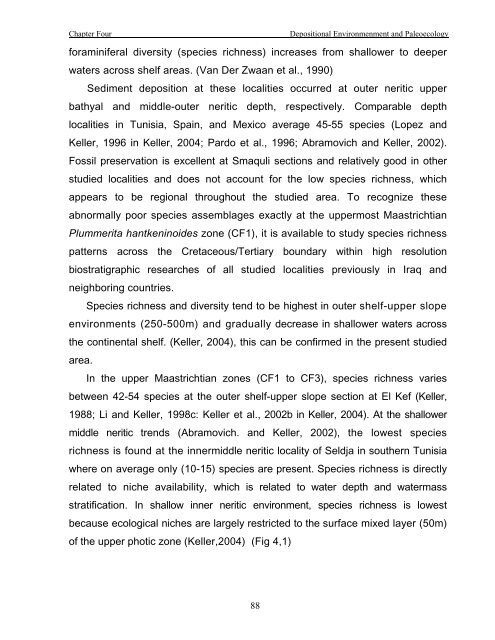biostratigraphy and paleoecology of cretaceous/tertiary boundary in ...
biostratigraphy and paleoecology of cretaceous/tertiary boundary in ...
biostratigraphy and paleoecology of cretaceous/tertiary boundary in ...
You also want an ePaper? Increase the reach of your titles
YUMPU automatically turns print PDFs into web optimized ePapers that Google loves.
Chapter Four<br />
Depositional Environmenment <strong>and</strong> Paleoecology<br />
foram<strong>in</strong>iferal diversity (species richness) <strong>in</strong>creases from shallower to deeper<br />
waters across shelf areas. (Van Der Zwaan et al., 1990)<br />
Sediment deposition at these localities occurred at outer neritic upper<br />
bathyal <strong>and</strong> middle-outer neritic depth, respectively. Comparable depth<br />
localities <strong>in</strong> Tunisia, Spa<strong>in</strong>, <strong>and</strong> Mexico average 45-55 species (Lopez <strong>and</strong><br />
Keller, 1996 <strong>in</strong> Keller, 2004; Pardo et al., 1996; Abramovich <strong>and</strong> Keller, 2002).<br />
Fossil preservation is excellent at Smaquli sections <strong>and</strong> relatively good <strong>in</strong> other<br />
studied localities <strong>and</strong> does not account for the low species richness, which<br />
appears to be regional throughout the studied area. To recognize these<br />
abnormally poor species assemblages exactly at the uppermost Maastrichtian<br />
Plummerita hantken<strong>in</strong>oides zone (CF1), it is available to study species richness<br />
patterns across the Cretaceous/Tertiary <strong>boundary</strong> with<strong>in</strong> high resolution<br />
biostratigraphic researches <strong>of</strong> all studied localities previously <strong>in</strong> Iraq <strong>and</strong><br />
neighbor<strong>in</strong>g countries.<br />
Species richness <strong>and</strong> diversity tend to be highest <strong>in</strong> outer shelf-upper slope<br />
environments (250-500m) <strong>and</strong> gradually decrease <strong>in</strong> shallower waters across<br />
the cont<strong>in</strong>ental shelf. (Keller, 2004), this can be confirmed <strong>in</strong> the present studied<br />
area.<br />
In the upper Maastrichtian zones (CF1 to CF3), species richness varies<br />
between 42-54 species at the outer shelf-upper slope section at El Kef (Keller,<br />
1988; Li <strong>and</strong> Keller, 1998c: Keller et al., 2002b <strong>in</strong> Keller, 2004). At the shallower<br />
middle neritic trends (Abramovich. <strong>and</strong> Keller, 2002), the lowest species<br />
richness is found at the <strong>in</strong>nermiddle neritic locality <strong>of</strong> Seldja <strong>in</strong> southern Tunisia<br />
where on average only (10-15) species are present. Species richness is directly<br />
related to niche availability, which is related to water depth <strong>and</strong> watermass<br />
stratification. In shallow <strong>in</strong>ner neritic environment, species richness is lowest<br />
because ecological niches are largely restricted to the surface mixed layer (50m)<br />
<strong>of</strong> the upper photic zone (Keller,2004) (Fig 4,1)<br />
88

















